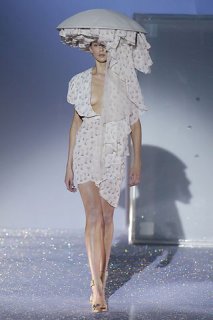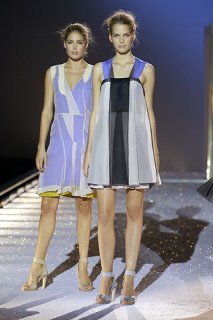laika said:
No, you were very clear. That makes perfect sense now.
*berates herself for not understanding
The Fold better*

I think these various ways of folding matter are very relevant to Chalayan's work. Pleating, pocketing, layers that aren't layers but extensions of a single garment--it definitely bears some relationship to the aesthetics of the drapery.
I think what bothers me is the notion that the body is the point of return for all of this.....I know Deleuze is obsessed with the body--and being a designer of clothes, Chalayan probably is too, to a certain extent--but I think HC is approaching the body in a different way. Naturally, I have not worked this out yet, so Multi, perhaps you can offer your thoughts, and tell me if I am misreading you again.
Even I berate myself for not understanding the
fold 
...
but lets comfort ourselfs that we can always fold, unfold and refold some more

...
I don't know if I'm right, but what I sense, which bothers you, is that the return to the body as a constant, as a point, but as you have captured in Chalayan, it's an extension of the body, and that is exactly the nature of the fold ...
The law of extremum of matter entails a maximum of matter for a minimum of extension. Thus, matter tends to flow out of the frame, as it often does in trompe l'oiel compositions, where it extends forward horizontally. Clearly some elements, such as air and fire, tend to move upward, but matter generally tends to unfold its pleats at great length, in extension.
- Gilles Deleuze The Fold: Leibniz and the Baroque
There is a multiplication of lines in width, this taste for masses and this heavy broadening of mass, this fluidity or viscosity that carries everything along an imperceptible slope, in great conquest of abstraction. As Wölfflin underscores ...
The gothic underlines the elements of construction, closed frames, airy filling; Baroque underlines matter: either the frame disappears totally, or else it remains, but despite the rough sketch, it does not suffice to contain the mass that spills over and passes up above.
- Heinrich Wölfflin Renaissance et Baroque
So it's indeed an extension, it is never a point! because the point is exactly that, a constant. The contrast between a constant and a becoming. As I have also suggested in Rei's design, as whatever assures the autonomy of folds of fabric in relation to the finite wearer; as themselves raising the material fold up to infinity; as derivative forces that materialize an infinite spiritual force.
Thank you very much for the article (Droogist

), I will admit I'm also obsessed with body, as a dancer and in the drawings I do, maybe why all this speaks so much to me, and what he says in this article, i think, echoes these notions of the fold and the Baroque ...
laika said:
I think its significant that his garments are frequently expressed in terms of things that we view as
extensions of the body--furniture, architecture, etc--and then in terms of something as interior and intimate as geneology.

And what you say here in the end, I think, is exactly that

...
"in every event to turn it inside out and to mold its inner surfaces." ...









 ) in our age of subjectivity, signification and simulacra is to make us 'belive' in the body( might be the significant of the nude body in the end of the show?!!!), to restore a direct self-awareness to the body. To interrupt signifiance and subjectification: the body itself becomes expressive. Chalayan opens thought onto the body, so as to give a voice to the body before all words(pre-historic?!!!), discovering its postures, capabilities, and the forces which work upon it.
) in our age of subjectivity, signification and simulacra is to make us 'belive' in the body( might be the significant of the nude body in the end of the show?!!!), to restore a direct self-awareness to the body. To interrupt signifiance and subjectification: the body itself becomes expressive. Chalayan opens thought onto the body, so as to give a voice to the body before all words(pre-historic?!!!), discovering its postures, capabilities, and the forces which work upon it.


 ...
... 































































































